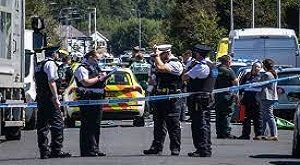The USS Carl Vinson (CVN-70) aircraft carrier stole the show at RIMPAC 2024, demonstrating cutting-edge naval capabilities and a powerful hint of the evolving US naval aviation strategy. The USS Carl Vinson (CVN-70) aircraft carrier displayed an advanced air wing.
Maritime News revealed that the USS Carl Vinson exhibited its high level air wing, known as CVW-2, during July’s semiannual Edge of the Pacific Activity, the world’s biggest global sea fighting activity.
The F-35C Lightning II, F/A-18E/F Block III Super Hornet, E-2D Advanced Hawkeye, EA-18G Growler, and MH-60R/S Seahawk are among the cutting-edge US aircraft included in the CVW-2.
According to the Naval News report, the carrier strike group demonstrated new capabilities such as the AN/ALQ-249 (V)1 electronic warfare (EW) pods for the EA-18G Growler, which enhanced its capabilities for electronic attack and cyber warfare. The long-range AIM-174B air-to-air missile was adapted from the surface-launched SM-6 Block IA.
It additionally says that the AARGM-trama center (AGM-88G), a high level enemy of radiation rocket, is likewise expected to enlist in the air wing’s weapons store.
According to Naval News, the USS Carl Vinson’s deployment in conjunction with the Air Wing Of The Future (AWOTF) concept is a component of the US Navy’s broader strategy to enhance its air wing capabilities across the entire fleet, particularly in the Pacific as it shifts its focus to the Indo-Pacific.
It says that this is the second time the USS Carl Vinson has used the AWOTF concept, following the deployment of F-35C Lightning IIs by the USS Abraham Lincoln.
Bryan Clark and Timothy Walton discuss the strategic challenges facing the US navy in light of the growing threats posed by China, Russia, Iran, and North Korea in a report that was published by the Hudson Institute in April 2022.
Clark and Walton accentuate how these potential foes improve their tactical capacities, especially in accuracy rockets, which can block US military tasks and power them to work from more noteworthy distances.
They feature the significance of airpower for accomplishing the essential reach to counter hostility, as maritime powers will progressively depend on air tasks to keep up with prevalence in challenged spaces.
According to Clark and Walton’s assessment, the “Navy Aviation Vision 2030-2035” document outlines the ends, means, and means of US naval aviation to ensure readiness, enhance capabilities, and address challenges from near-peer adversaries. They emphasize the necessity of evolving US naval aviation strategies and capabilities in order to address these sophisticated threats and ensure effective maritime operations in a high-threat environment.
The document identifies the following strategic goals for US naval aviation:
Keeping the Maritime Advantage: Make sure that the US Navy is able to project power and take control of the sea in any maritime theater.
Increasing Readiness and Lethality: Create a force with advanced capabilities and preparedness that can defeat all opponents.
Supporting the Strategy for National Defense: Adjust maritime aeronautics force structure with the US Public Safeguard Procedure to discourage and overcome enemies actually.
The following are the strategies or lines of effort that US naval aviation will employ to achieve its strategic goals:
DMO stands for distributed maritime operations. Put DMO into action to give you a strong, coordinated maritime component that can deliver both lethal and non-lethal efforts from a variety of axes and domains.
Programs for Advanced Training: Alter preparing through drives like Maritime Aeronautics Preparing Straightaway (NATN), Live/Virtual/Productive (LVC) preparing, and Air Wing Fallon preparing to plan for top of the line dangers.
Key Organizations: Team up with industry to foster open design frameworks, guaranteeing quicker and more viable joining of new advances.
It likewise makes reference to the resources expected to execute the technique, explicitly plane carrying warships, transporter strike wings (CVW), automated aeronautical frameworks (UAS), high level weapons (i.e., hypersonic weapons), coordinated organizations and preparing frameworks.
However, Matt Wright mentions in an article published by the US Naval Institute in March 2024 that, despite the significant transition of US naval aviation to the AWOTF concept, the introduction of new technologies such as the MQ-25A Stingray for aerial refueling has been postponed, which has impacted operational capabilities.
Wright says that operational readiness is delayed because of difficulties integrating new technologies like the electromagnetic launch system (EMALS) and advanced weapons elevators.
He claims that the MQ-25A Stingray’s aggressive development test and evaluation plans caused production delays and pushed back initial operational capability (IOC) dates.
Wright points out that accidents like the V-22 Osprey crash in Japan in November 2022 have slowed the transition from C-2A Greyhounds to CMV-22s and forced all V-22 variants to be grounded.
He specifies that strict spending plans have affected the generational change in maritime flying, influencing the acquisition and presentation of new stages and weapons frameworks.
In addition, at the Naval Aviation 3-Star Summit in Lexington Park, Maryland, in May 2024, key leaders from the Naval Aviation Enterprise discussed important issues affecting US naval aviation.
The board, including US Maritime Air Frameworks Order (NAVAIR) authority Bad habit Chief of naval operations Carl Chebi and other high-positioning authorities, resolved issues, for example, enrollment and maintenance, financial plan imperatives and the requirement for fast development to stay up with industry abilities.
They emphasized the significance of utilizing existing authorities to enhance warfighting capabilities and flexibility in the requirements process. Automation, artificial intelligence, and machine learning were also discussed as ways to improve aviation logistics and safety, particularly in high-end combat situations.
The culmination highlighted the continuous endeavors to modernize preparing frameworks including by supplanting the T-45 Goshawk and teaming up with different administrations and industry accomplices to foster future weapons arrangements.
Alex Karma notes in a Walk 2024 article for Maritime News that China’s maritime flight capacities are progressing with critical improvements in its plane carrying warship programs.
Karma makes reference to that China’s Liaoning transporter has finished a midlife modernization in Dalian while the new Fujian transporter is going through ocean preliminaries.
He says that the Fujian, China’s most memorable sling prepared transporter, is supposed to improve Individuals’ Freedom Armed force Naval force’s (PLA-N) functional limit.
He talks about the new Chinese aircraft, like the KJ-600 airborne early warning and control plane, which looks like the E-2 Hawkeye from the US Navy, and the J-35 fighter, which is supposed to be the next-generation aircraft to replace the J-15.
According to Luck, the J-15, China’s primary carrier-based fighter that is deployed on the Liaoning and Shandong carriers, has also undergone modifications, including variants for electronic warfare, training, and catapult launch.
He points out that these developments point to a significant development in China’s efforts to modernize its carrier fleet and increase its capacity for maritime power projection.
On Aug. 6, at Naval Air Station Oceana, Secretary of the Navy Carlos Del Toro hosted an all-hands call for the Carrier Air Wing (CVW) 3 squadrons. Last month, CVW-3 returned from a nine-month deployment to the U.S. 5th and 6th areas of operation as part of the Dwight D. Eisenhower Carrier Strike Group (IKECSG).
Secretary Del Toro praised the men and women of CVW-3 as the upcoming generation of mentors for Naval Aviation during the ceremony.
“The fearless champions of the Vietnam period are who I gazed upward to,” said Secretary Del Toro. ” You are currently the new age of mentorship for junior officials and the individuals who will join Maritime Avionics. I am proud to be here with you today and acknowledge that I am surrounded by heroes. Thank you, thank you, and I am incredibly proud of everything you accomplished. Best wishes and welcome back.
While sent with IKECSG, CVW-3 flew in excess of 13,800 fights for in excess of 31,000 absolute flight hours and finished in excess of 10,000 airplanes dispatches and recuperations.
Secretary Del Toro went on to say, “The achievements and actions of Carrier Air Wing 3 are indeed worthy of the Navy Unit Commendation and Combat Action Ribbon awarded earlier this year.” For almost nine months, Transporter Air Wing 3 conveyed uncommon maritime power as a component of the IKE Strike Gathering, guarding guiltless non military personnel vendor sailors in waters basic to the progression of global business.”
Capt. James Huddleston, representative leader, CVW-3, accentuated the colossal cooperation expected to keep up with opportunity of route in the Red Ocean.
According to Huddleston, “this deployment showed how dynamic a carrier strike group is, with the ability to protect the freedom of navigation worldwide.” We haven’t worked in that frame of mind for quite a long time, and here and there, not since The Second Great War. This air wing’s squadrons made history, and they ought to be particularly proud of their performance and mission.
Cmdr. The operations officer for CVW-3, Nolan Lucas, expressed his appreciation for the Secretary of the Navy’s visit.
Lucas stated, “Having the Secretary of the Navy visit with the wing means a lot.” At the point when you’re on arrangement, you really live at the time and are centered around the mission before you. Knowing that what we did made a difference, approves our presence and reason.”
All squadrons entering the U.S. 5th Fleet area of operations will benefit from the lessons learned from CVW-3, according to Naval Air Force Atlantic commander Rear Adm. Doug Verissimo.
“These groups splendidly executed at risk for quite a long time to monitor unified and accomplice intrigues in the Red Ocean,” said Verissimo. ” Our carrier strike groups’ bravery is inspiring all over the world. The American public ought to have confidence realizing that the people of Maritime Flight are dependably prepared. The encounters of Transporter Air Wing 3 will direct and inspire all Maritime Aviation based armed forces as they get ready and execute our Country’s entrusting.”
The “Gunslingers” of Strike Fighter Squadron (VFA) 105, the “Fighting Swordsmen” of Strike Fighter Squadron (VFA) 32, the “Rampagers” of Strike Fighter Squadron (VFA) 83, the “Wildcats” of Strike Fighter Squadron (VFA) 131, the “Screwtops” of Carrier Airborne Early Warning Squadron (VAW) 123,
Providing combat-ready, sustainable naval air forces with the right personnel, properly trained and equipped, with a focus on readiness, operational excellence, interoperability, safety, and efficient resourcing is the primary focus of Naval Air Force Atlantic, which is responsible for six nuclear-powered aircraft carriers, 55 aircraft squadrons, 1,200 aircraft, and 52,000 officers, enlisted, and civilian personnel.








